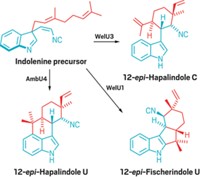Advertisement
Grab your lab coat. Let's get started
Welcome!
Welcome!
Create an account below to get 6 C&EN articles per month, receive newsletters and more - all free.
It seems this is your first time logging in online. Please enter the following information to continue.
As an ACS member you automatically get access to this site. All we need is few more details to create your reading experience.
Not you? Sign in with a different account.
Not you? Sign in with a different account.
ERROR 1
ERROR 1
ERROR 2
ERROR 2
ERROR 2
ERROR 2
ERROR 2
Password and Confirm password must match.
If you have an ACS member number, please enter it here so we can link this account to your membership. (optional)
ERROR 2
ACS values your privacy. By submitting your information, you are gaining access to C&EN and subscribing to our weekly newsletter. We use the information you provide to make your reading experience better, and we will never sell your data to third party members.
Biological Chemistry
Enediyne biosynthetic intermediate found
Iodoanthracene derivative is key intermediate en route to dynemicin A
by Stu Borman
March 19, 2018
| A version of this story appeared in
Volume 96, Issue 12
Since the first enediyne was discovered in 1985, scientists have been fascinated by this family of over a dozen natural products. The source of the compounds’ potent anticancer activity is their highly reactive enediyne unit, a double bond flanked by two triple bonds, which cleaves or cross-links genomic DNA by a unique molecular mechanism. Several enediynes are approved drugs or in clinical trials. Bacteria biosynthesize enediynes with multiple reactions that modify β-hydroxyhexaene, a common enediyne precursor produced directly by polyketide synthase enzymes. But many details of these pathways remain unknown. Craig Townsend and Douglas Cohen at Johns Hopkins University recently showed that the two parts of dynemicin A, an anthraquinone group and the enediyne moiety, are produced from β-hydroxyhexaene independently and are then combined to form the natural product. Using pathway product profiling, chemical analysis, and crystallization, Townsend and Cohen have now identified an iodoanthracene derivative as a key intermediate on the pathway to the anthraquinone component (Angew. Chem. Int. Ed. 2018, DOI: 10.1002/anie.201802036). The finding could help lead to better ways to produce enediynes in sufficient quantities for research and clinical use.




Join the conversation
Contact the reporter
Submit a Letter to the Editor for publication
Engage with us on Twitter